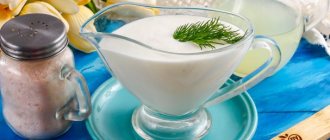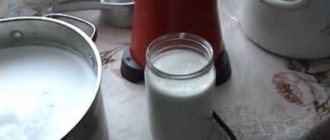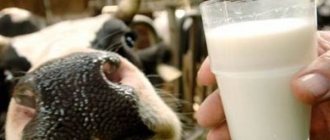Goat milk is a product that is definitely worth paying attention to for those who care about their health. Not surprising: by drinking this wonderful artiodactyl drink, you can help the body receive the necessary beneficial microelements that have the most beneficial effect on health.
One of the products that can be made from goat milk and has excellent taste and benefits is cottage cheese. There are several simple recipes for its preparation.
Goat milk cottage cheese with whey
- If you need to get 1 kilogram of cottage cheese at the end, you need to prepare 6 liters of goat milk, pour them into 3-liter jars and put them in a warm place for ripening. This could be heated floors or a window sill in a room on the sunny side, in a word, monitor the temperature, otherwise the milk will not sour, but simply spoil.
- To speed up this process, add ½ cup of sour whey to each jar, or dilute two tablespoons of ready-made cottage cheese in half a glass of warm milk and also divide among jars.
- If it happens in the summer, the yogurt will be ready in a day, in the winter - in 2 - 3 days. You can determine the degree of its readiness by the pieces of the separated mass.
- The most crucial stage is coming. Heat the curdled milk in a water bath. To do this, place the jars in high pans and gradually heat them over low heat for twenty minutes. At this time, you can mix the mass from bottom to top two or three times. As a result, the whey sinks to the bottom of the jars, and the curd ends up on top. The jars need to be removed from the pans and allowed to cool.
- Strain the cooled contents through gauze folded in half. Or you can first drain the whey through a rubber tube, and only then strain the cottage cheese through cheesecloth. Tie the gauze in a knot and hang it overnight. In the morning, the delicious “homemade goat milk cottage cheese” you prepare will be good both in its natural form and with the addition of honey, jam, and fruit. For breakfast there is nothing better than cheesecakes or cottage cheese casserole.
Classic recipe
The technology for making a classic fermented milk product is incredibly simple. Making cottage cheese from goat's milk at home will not be difficult for you.
- Pour the dairy product into a saucepan, boil and add salt. Leave in a warm place so that it sours. This process will take about a day.
- Heat the sour milk on the stove, but do not boil, otherwise you risk getting a boiled and tasteless product.
- Place gauze or a waffle towel folded several times at the bottom of the colander. Place in a colander and allow the resulting whey to drain. Then tie gauze or a towel in a knot and hang it for several hours. After this, the excess whey will finally drain and the cottage cheese can be tasted.
Goat milk cottage cheese with sour cream
A jar of ½ liter of goat's milk needs to be brought to a warm state in a water bath. Then it will sour for at least two days. We speed up this process by adding just one spoon of sour cream to the milk. We notice that air bubbles have begun to rise from the milk, which means we already have yogurt in the jar. The process of curd formation has begun. Place the jar back in the water bath and heat over low heat for about 15 minutes. Then place a colander in a bowl, cover it with gauze and pour the fermented milk mixture through it. We tie gauze in the shape of a bag and hang it for 4-5 hours to allow the whey to drain. After this, we untie the bag and take out the finished cottage cheese. This method takes a lot of time, but it is accessible to any housewife who would like to make goat milk cottage cheese at home.
It is important!
- if you make cottage cheese from goat milk at home in a room where the temperature is below 25 degrees, the milk may not sour, but simply spoil. To speed up ripening, add a little whey from the previous batch or two tablespoons of cottage cheese, previously diluted in 0.5 cups of warmed milk.
- You can only use unboiled milk that you are sure of its quality. If in doubt, you can make cottage cheese from boiled milk
- Only perfectly clean gauze, a stainless steel colander or wicker baskets are suitable as a filter.
- Serum is also useful in the household. You can use it to make dough for pancakes or pancakes, make okroshka or cold soup. The serum is also used for cosmetic purposes - to improve hair and skin. The only condition is storage in the refrigerator for no more than 10 days.
Adviсe
Whatever recipe is chosen for preparation, an appetizing recipe is only half the success in order to please your loved ones with a delicious dish. It is much more important to follow some recommendations, with the help of which the cottage cheese will turn out really tasty and will retain this property during storage:
- It is recommended to boil fresh goat milk first to avoid infections. It is advisable to use an unprocessed product only if it is purchased from a trusted seller.
- All utensils, fabrics and other devices used in the process of making cottage cheese must be clean, as well as the hands of the housewife. At this point, you should pay special attention if the product is intended for a child.
- You can choose the calorie content of the future product yourself depending on the calorie content of the milk used.
- It is not recommended to store freshly prepared goat curd for more than 3 days - the product not consumed within this period should be frozen.
- It is recommended to store the finished product in the freezer in a closed container to avoid the introduction of foreign odors.
- When preparing a dish, it is recommended to always use a kitchen thermometer - otherwise the milk will not sour properly, but will simply spoil and acquire an unpleasant aftertaste.
- Since some people may have an allergic reaction to goat's milk, before making cottage cheese from it, you need to make sure that there are no symptoms of this problem.
- It is necessary to correctly calculate the mass of the finished product correctly - from 3 liters of milk you get about 650–700 g of finished cottage cheese.
- To ensure proper souring, it is necessary to ensure a room temperature of at least 25 ° C, otherwise the milk will not reach the desired state.
- Since the finished product has a specific aroma, it is recommended to add spices or herbs to it.
- The whey obtained during the process should not be thrown away - you can use it to make delicious pancakes or pancakes.
Goat milk cottage cheese according to an old recipe
Practice has proven that simple folk recipes for preparing fermented milk products successfully compete with the newest ones. Try making goat milk cottage cheese at home from “young” curdled milk. To do this, one liter of fresh milk must be kept in a warm place for one night. During this time, the souring process will begin. In the morning, put another liter of fresh milk on the fire, and when the foam begins to rise, pour the “young” yogurt into the pan. This whole mixture should boil; you need to remove the pan from the heat at the moment when a yellowish-greenish liquid forms at the top. Drain off the whey and carefully spoon the curd into a container. Knead it until the whey is completely separated. So skyr is ready - cottage cheese with a unique pleasant taste and delicate consistency. In fact, this type of crumbly cottage cheese came into Russian cooking from the Norwegian national cuisine, but over several centuries it has become loved by many Russians.
If you already have a multicooker, then the process of making cottage cheese at home will be even easier.
- Buy three liters of homemade goat milk, add a glass of kefir to it, stir well and leave for a day in a warm place. The curdled milk should be thick, with dense flakes.
- Carefully pour it into the multicooker bowl, no need to stir, so that the cottage cheese looks more appetizing and grainy.
- Turn on the “Heating” mode for three hours. After this, drain everything through a fine sieve. The cottage cheese is ready!
And one more folk recipe. Many young mothers include cottage cheese in their child’s daily menu. Portions are correspondingly small. That’s why we use a half-liter package of organic goat’s milk yogurt. Place a container with organic yoghurt in the preheated and already turned off oven, where it will remain for at least 6 hours. Literally after an hour, the yogurt thickens and curls into curd flakes. And after the specified time, the mass must be strained. Children enjoy eating this delicate cottage cheese, which has a consistency similar to sour cream.
It is important!
- Goat cottage cheese is a dietary product. It is introduced into the diet of infants from the age of six months, when bone tissue is formed. It is extremely useful for expectant mothers and elderly people, as it improves metabolism.
- In terms of protein content, cottage cheese is equal to meat, poultry, fish and is completely absorbed by the human body. The amino acid methionine contained in goat cottage cheese can lower cholesterol levels.
- Having received fresh cottage cheese at home, try to use it within three days. And if goat curd is frozen, it will not lose its taste.
Many people know about the beneficial properties of such a wonderful food product as goat milk. Most rural residents who have domestic goats believe that its nutritional value is significantly superior to cow's milk. However, it is worth noting that not everyone likes this product due to its taste. Some people are put off by the specific smell of goat milk, which intensifies when heated. But if you prepare fermented milk products or cheese from it, which abound in the national cuisine of the Mediterranean and North Caucasus countries, then the unpleasant aftertaste is not felt at all. In particular, goat milk cottage cheese is perfectly absorbed by the digestive system and has excellent taste characteristics, which is very useful for people of any age. It has a positive effect on the functioning of the gastrointestinal tract, and this product can be safely consumed even by people allergic to cow's milk.
Calorie content
The product is good to use when losing weight; it will be useful for obesity or for those who are watching their shape. But in general, a gift from a goat is suitable for everyone.
Goat cheese is considered a dietary product; it is consumed by both young and old; it will also benefit pregnant women. In terms of protein content, cottage cheese is close to meat. Calorie content of the product per 100 grams:
- water – 71 g;
- proteins – 16.7 g;
- fats – 9 g;
- carbohydrates – 1.3 g;
- kcal – 156.
100 grams of cottage cheese contains so much calcium that it almost completely satisfies a person’s daily dose.
Beneficial features
Today in supermarkets you can easily find cottage cheese made from goat's milk. Moreover, this is a rather expensive product due to the specifics of industrial production. In the production of goat cheese, lactic acid thermophilic bacteria are used, which contribute to the precipitation of the protein fraction and increase its concentration in the original product. And the albumin protein present in this cottage cheese is extremely useful for preventing osteoporosis, as well as for a growing child’s body during the formation of bones and teeth. In addition, the vitamin and mineral composition of goat curd is characterized by a high content of calcium, phosphorus, folic acid, potassium, and B vitamins. Therefore, goat curd is one of the most valuable food products. Only when choosing industrially produced cottage cheese should you pay attention to the quality of the product: it must be of uniform consistency and free from foreign inclusions. Well, if you have the opportunity to get fresh goat milk, then it is quite possible to prepare cottage cheese at home.
Story
No one knows the exact date and place of cottage cheese production. There are suggestions that this happened by accident. But the fact that the product is very ancient is proven by records made back in the first century AD by Roman scribes.
In ancient Rus' they also loved cottage cheese, although they called it cheese. Under Great Peter the Great, hard cheeses began to appear on tables, so they began to separate the products and call them differently. The Poles overheard the name tvorog, but in the Russian version tvorog they simply shifted the emphasis.
Cottage cheese comes from the word “to create.” Before serving it, the product must be prepared. In one old book about nutrition it is written - “cottage cheese was made from milk.”
Homemade goat curd
When making cottage cheese from goat's milk yourself, you will need to take into account some nuances. Firstly, milk should be purchased from a reliable supplier who has a quality product. Secondly, to get half a kilogram of cottage cheese, you need to stock up on 3 liters of milk. Thirdly, if the temperature in the room for fermenting milk is below 25°, it may spoil. Fourthly, you will need a starter: half a glass of whey, or a couple of tablespoons of high-fat sour cream.
Chemical composition
Goat curd is a storehouse of various elements and minerals. It contains much fewer allergens than cow's milk, although there are more fats than cow's milk, but they are easily digested. The methionine content helps regulate the amount of cholesterol in the body and improves metabolism.
Ingredients of goat cheese made from whole milk:
- vitamins A, B, C, D, PP;
- proteins;
- enzymes;
- fats;
- carbohydrates – lactose (milk sugar), galactose;
- minerals - phosphorus, calcium, iron, copper, as well as fluorine, zinc, selenium, magnesium, potassium, sodium;
- hormones.
Goat cottage cheese is suitable for everyone; it is included in the category of the most valuable food products. Doctors recommend using it daily.
Preparation
The process of making goat cheese itself is not particularly difficult. Pour the starter into a three-liter jar and leave the milk to ferment. As already noted, the room should be warm. In winter, the jar can be placed near the heating radiator in the kitchen, in summer it can be placed on the windowsill in sunny weather. Gradually, the goat's milk will turn into curdled milk: in the jar you will notice the beginning of separation of the product into whey and curd mass. Usually it takes 2–3 days to ferment milk.
The next step in preparing goat curd is a water bath. To do this, place a jar of fermented milk in a pan of water and heat slightly over low heat. After twenty minutes, the whey will be at the bottom of the jar, and the curd mixture will rise to the top. Then the contents of the jar need to be cooled and you can start filtering it.
Take clean gauze, fold it in 2-3 layers, place it on a sieve and pour out the resulting sour-milk mass. Most of the liquid will go away. After this, tie the ends of the gauze with the curd in it and make a bag that will need to be hung for the final drainage of the whey. After a few hours, the tender crumbly goat milk curd will be ready.
Homemade goat curd is a healthy breakfast for children, adult family members and the elderly. Moreover, it does not lose its nutritional and taste qualities even when frozen. Give your preference to healthy food!
The information on our website is informative and educational in nature. However, this information is in no way intended to be a guide to self-medication. Be sure to consult your doctor.
Cottage cheese is a very healthy and tasty product that should definitely be present on your table. This is especially important if there are small children in the family. It turns out that making goat milk cottage cheese at home is not difficult at all. It is enough to know a few rules and secrets.
Kefir or yogurt
You can try making cottage cheese at home from kefir and yogurt. The cooking process is the same as in the first recipe, but instead of milk we use one or the other. The fat content of the resulting cottage cheese will depend on the fat content of kefir, and the yogurt, of course, should be natural, “live”, without dyes or fruit additives. It’s better to put pieces of fresh fruit into our cottage cheese ourselves.
Let's prepare cottage cheese from sour milk
Remove only part of the whey thoroughly enough to wet a clean cotton bag.
Place the cotton bag on the pan or drain and carefully remove the dough using a slotted spoon and place it in the bag. After time has passed and the dough is a little dry, move to the pool until the season. Sowar well until smooth and then add salt and fine herbs or other seasonings. Burin cheeses can be served in several ways. In the form of balls with or without seasonings, wrapped in parsley, curry, pepper, etc. - in small balls placed in glasses with olive oil. - Accompany bread and toast in paelas. - in bulk to accompany cooked meat. - in pasta fillings.
Traditional cottage cheese made from sour goat milk
Goat milk is valued much higher than milk milk due to its healing properties. It improves immunity and improves health, curing many diseases. This wonderful product is useful for people of all ages, and especially for children. In those regions where goat milk and products made from it are present in the diet every day, people get sick much less often, and there are much fewer problems with excess weight.
Goat milk cottage cheese does not cause allergic reactions, it is easier to digest by the body, and is useful for many diseases of the gastrointestinal tract, joints, respiratory tract, as well as for insomnia.
Goat milk cottage cheese is not only tasty, but also a very healthy product.
For traditional cottage cheese, quite simple to prepare, you will need:
- 1 liter goat milk;
- 3 pinches of table salt.
Goat milk, if it is fresh, takes a long time to sour. To speed up this process, boil the milk and add a little salt to it. After this, cover the container with a lid or gauze and leave for a day in a warm place. This is enough for the milk to ferment. The warmer it is, the faster it will curdle, that is, it will separate into whey and almost finished curd.
- Pour the sour milk into an enamel bowl and place on low heat until it warms up slightly. There is no need to bring it to a boil, otherwise the cottage cheese will be boiled and taste unpleasant.
- Take a deep bowl, place a colander in it, covered with gauze folded 2-3 times. The fabric should be wider than the colander, so that it is enough to strain the curd.
- Pour well-heated sour milk into a colander. Wait until all the whey has gone through the cheesecloth into the bowl. Gather the edges of the gauze, lift the curd mass and allow the remaining liquid to drain.
- After this, hang the bag of cottage cheese for about 1-2 hours over a deep bowl: during this time, the last whey will drain, and your cottage cheese will be finally ready for use.
By the way, don’t throw out the whey: it can be used to make excellent pancakes and pastries!
Product for children
This cottage cheese can be introduced as complementary food to babies, and can also be given to older children for breakfast.
It is important to use the freshest possible ingredients for its preparation and not to prepare the product for future use.
For children's cottage cheese you only need one ingredient - children's kefir.
It is prepared as follows:
- The required amount of kefir is slowly heated in a water bath.
- As soon as the product begins to coagulate, place it in a colander or cheesecloth and allow the whey to drain.
After the resulting mass has cooled, it can be given to the child immediately.
Cooking in different ways
Take 0.5 liters of goat milk, pour it into a jar and heat it in a water bath. After this, it will sour for at least 2 days, but we will speed up this process by adding one tablespoon of sour cream. Once noticeable air bubbles begin to rise from the milk (that is, curdled milk has formed), place the jar in a water bath and heat again over low heat, about 15 minutes.
Drain the resulting mass through a colander covered with gauze. Hang the resulting bag of cottage cheese for several hours to drain the whey. You can squeeze the gauze a little so that the liquid leaves faster.
Containers with goat milk should be kept in a warm room to speed up ripening
The following recipe is similar to the very first one in this article, traditional. But it is more complicated and will require more time from you. But the cheese will turn out original and especially tasty.
- Take 1 liter of fresh goat milk and keep it in a warm place overnight. The milk will begin the process of souring.
- In the morning, take another 1 liter of fresh milk and put it on the fire. When the milk starts to foam, pour in the young sour milk. Boil this mixture and remove the pan from the heat at the moment when a yellowish-greenish liquid forms on top.
- Drain off the whey and carefully place the curd into the prepared bowl. Mash it with a spoon to release any remaining whey.
This cottage cheese is called skyr, it came to us from Norwegian cuisine. It has a delicate consistency and a peculiar pleasant taste.
If you have a slow cooker, the process of making goat cheese curd will be much easier.
Add 1 glass of kefir to a container with 3 liters of fresh milk, mix thoroughly and leave in a warm place for a day. You should get thick yogurt with dense flakes. Pour it into the multicooker bowl without stirring - this will make the cottage cheese grainy and more appetizing. Turn on the “Keep Warm” mode for about 3 hours. After this, just drain off the whey, and your cottage cheese is ready!
It's no secret that many mothers try to include cottage cheese in their children's daily diet. But not every child likes this product in its usual form. You can “outsmart” your baby and prepare small portions of cottage cheese from yogurt for him.
Take 0.5 liters of bio-yogurt from goat milk. Preheat the oven, turn it off and place the carton of yogurt in it. It should remain there for at least 6 hours while the oven cools down. Within an hour, the yogurt will thicken and begin to curl into flakes. After 6 hours, you need to strain the resulting mass. This cottage cheese has a consistency similar to sour cream.
Note! The gauze for straining the cottage cheese must be absolutely clean. It is better to use a colander made of stainless steel or enameled. You can also use wicker baskets. But all dishes must be perfectly clean.
If the temperature in the room where you make cottage cheese is below 25 degrees, the milk may spoil instead of sour. Therefore, we try to speed up the ripening by adding whey from the previous cottage cheese.
Use only clean dishes and gauze to strain the cottage cheese.
You must be sure of the quality of the fresh milk from which you are going to make cottage cheese. If you are not sure, it is better to boil the milk.
As we have already said, there is no need to pour out the whey - it will be useful to you not only in preparing many dishes, but also for cosmetic purposes. But do not forget that it should be stored in the refrigerator for no more than 10 days.
Once you make homemade goat milk curd, try to consume it within 3 days, otherwise it may go bad. But if goat curd is frozen, its taste will not decrease.
Storage
The product is placed in glass, enamel or earthenware containers. The container must be tightly covered; cottage cheese tends to absorb odors. When placing in the refrigerator where cutlets, borscht and adjika with garlic are stored, it is better to cover the product. The shelf life in the refrigerator is 3 days, at a temperature no higher than + 8 degrees, after which the cottage cheese spoils.
A barely perceptible smell will begin to appear, then the curd lumps will become covered with a barely visible coating and become slippery. A product purchased in a supermarket is placed in packaging on which the expiration date must be indicated. If it exceeds 3 days, it means that the cottage cheese contains preservatives.
Video about making goat milk cottage cheese at home
Goat cottage cheese is an incredibly healthy product containing a lot of substances necessary for the body. Now you know that making it yourself at home is not at all difficult, and you will probably include it in your family’s diet. If you have experience in preparing such cottage cheese, share with us in the comments. Bon appetit and good luck to you!
If you are interested in having such a healthy food product as cottage cheese regularly present on your table, and you have no doubt about its quality, especially if you have small children, then it is much easier, safer and healthier to cook cottage cheese from yourself at home.
Having learned in detail from our master class how to make goat milk cottage cheese at home, you will be surprised at how simple it is, and even more surprised at why you haven’t done this before.
The most important thing, before you start preparing cottage cheese, is to purchase fresh, tasty milk for this purpose. There can be three options: store-bought pasteurized milk, whole cow's milk and the healthiest health milk, goat's milk. In principle, the preparation of cottage cheese from any type of milk is done in the same way, only the result is different, but there is a unifying result of such preparations; in any case, the cottage cheese turns out much tastier than store-bought. In this master class we will tell you how to make cottage cheese at home from goat milk, as it is the most beneficial for children's and dietary nutrition. As we have already said, homemade cottage cheese from other types of milk is prepared in the same way.
Dietary
If you are planning to make low-fat cottage cheese at home, you must either immediately use low-fat milk as a base, or skim off the cream from the milk that is starting to sour during the cooking process. This creates a low-fat dietary product for those who are watching their weight or following a diet.
Portuguese goat cheese is a light and smooth cheese that pairs well with fruit and honey. This cheese is very popular in Portugal, for breakfast with bread, jelly or served on small plates as a snack. Goat cheese became popular in Portugal even before the Roman era. Globally, goat's milk products are considered healthier and easier for humans to digest due to their high levels of fatty acids, unlike cow's milk which contains high levels of fat. The composition of goat's milk is similar to that of dairy milk.
It can be used to make cream and other types of cheese such as cottage cheese or ricotta. However, the most famous Portuguese goat cheese consists of a slab of soft cheese made by molding rennet and allowing it to dry quickly.
How to make cottage cheese at home, preparation:
It should be noted right away that homemade cottage cheese made from goat’s milk fermented with sour cream turns out to be so tasty that you can enjoy it as a cream paste; there is practically no graininess. To achieve exactly this result, it is important not to overheat the fermented milk, then you will get the most delicate cottage cheese, a ready-to-eat delicacy that does not require additional “flavoring.”
1) So, pour the milk into an enamel pan and put it on the fire, heat it to about 40 o C. Photo 1.
2) Place sour cream in warm milk, stir it very thoroughly in the milk. For a more uniform distribution in the milk, you can first dilute the sour cream in a small amount of milk and then pour it into the pan. Photo 2.
By the way, in order to get cottage cheese at home, milk can be fermented with ready-made yogurt or kefir; again, the taste of such cottage cheese will be different from cottage cheese fermented with sour cream. In order to understand what flavor of homemade cottage cheese suits you best, you need to try all the proposed options, and your household will only be happy with such a series of experiments, since they will be lucky enough to enjoy homemade cottage cheese quite often.
3) Continuing to describe how to prepare cottage cheese at home, we proceed to the next step, namely, after we have heated the milk, close the pan with a lid and, wrapping it with something heat-retaining, leave for eight hours or overnight. The next day, we check our fermented milk with a spoon; if the milk mass has become very dense, then, after stirring it, put it on low heat.
After about twenty minutes, you need to mix the fermented milk, there are two options: if you want to get fine-grained cottage cheese, then you should mix boldly and thoroughly. If you are interested in getting large flakes of cottage cheese, then mix carefully, moving the large spoon only up and down. Photo 3.
We mixed the milk thoroughly, making movements in a circle, including at the same time checking the temperature of the curdled milk by simply dipping a finger into it, the mass should be unbearably hot. If you use a special thermometer, then the temperature of the curdled milk should be approximately 80 - 85 o C. In this case, turn off the heat, close the pan with a lid and place it in a spacious container filled with cold water.
4) After the pan with heated yogurt has cooled to the temperature of cold water (if necessary, you can make two or three changes of water), pour the mass into a deep colander lined with a dense, but well-permeable fabric. Photo 4.
5) We tie the fabric on top and, leaving the entire mass in a colander, put everything in the refrigerator for a day, periodically draining the released whey. Photo 5.
Goat milk is a wonderful dietary product with unsurpassed quality characteristics. However, not everyone loves it because of its specific taste and smell. It is much more pleasant to eat fermented milk products made from it, for example, cottage cheese. It retains all the beneficial properties of fresh milk. It is perfectly absorbed by adults and children, helps strengthen the immune system and enriches it with calcium.
For the baby
The child begins to be given cottage cheese from five to six months - in a thoroughly mashed form, at the very beginning of feeding. The dose gradually increases to 30 grams, so there is no need to prepare the curd on a global scale. By the age of one year, the daily norm is only 50 grams. Do not give such young children cottage cheese that is sold in markets, as it has a short shelf life and the fat content is not entirely suitable. It’s better to make cottage cheese at home.
Boursina cheeses on the market. Liliya Metchnikova, a Russian biologist, studied and managed to isolate the bacilli from yoghurt, a staple of the Bulgarian food supply, known for its longevity. The largest consumers of yogurt in the world are the countries of Europe and Asia. Over the past 10 years, consumption has increased by more than 100%. Sales value increased by 32% compared to the previous year. This is due to the production of yogurt with various and exotic fruits, light and dietary compositions with the addition of calcium, iron and vitamins.
Features of preparing goat cottage cheese at home
To make cottage cheese from goat milk on your own, you need to know a few rules:
- To make the product, milk that is not entirely fresh is taken.
- The air temperature in the room where it will be fermented must be at least 25°C.
- To speed up the process, ferment is added to the milk - sour cream, whey, natural yogurt.
- From 3 liters of milk you get about 0.5 kg of cottage cheese.
- Goat cottage cheese is consumed within 2-3 days. In some cases it is frozen. At the same time, it does not lose its beneficial properties.
How to choose
Among the abundance of product options, it is not easy to find real goat curd. It is best to take it from well-known grandmothers at the market. In stores the product will be of lower quality. When examining the cottage cheese, you should pay attention to:
- for color - the product must be white without any foreign particles;
- consistency is homogeneous;
- aroma without unpleasant shades, a self-respecting housewife, before milking the animal, thoroughly washes her hands and the goat's udder;
- the taste should not be bitter, the cottage cheese is either old, or the goat has eaten wormwood.
If you don’t trust anyone, you can make cottage cheese at home; it is also important to store homemade goat curd correctly. The product has a short shelf life.
Making goat curd at home
Ingredients:
- goat milk - 3 liters;
- whey - 0.5 cups or fat sour cream - 1-2 tbsp. l.
Preparation:
- The milk is poured into a three-liter jar, the starter is added to it and placed in the warmest place in the kitchen for fermentation. This process is long - from 2 to 3 days.
- After separating the whey and curd mass, the jar with the contents is placed in a water bath and slightly heated. This is necessary to compact the curd. This will take no more than 20 minutes.
- Place clean gauze, folded in three, on a sieve or colander and pour the contents of the jar onto it. The ends of the fabric are tied, the resulting bag is hung on a hook, and a container is placed under it into which the whey will drain.
- The whey is collected and used in the next preparation of cottage cheese, in home baking, beauty treatments, or simply drunk.
- After 4-5 hours, the curd mass in gauze will turn into a crumbly, aromatic and very tasty dish.
Homemade goat milk cottage cheese is eaten fresh with jam, candied fruits, and simply sprinkled with granulated sugar. Cheese pancakes and casseroles are made from it. In dietary nutrition, such a product is much more preferable than a regular one made from cow's milk.
Fermented milk products made from goat milk are expensive. Therefore, it is more profitable for cottage cheese lovers to make it themselves from whole milk.
With sour cream
At home, you can cook goat milk cottage cheese using sour cream.
Sour cream will help speed up the natural ripening process.
- Pour the milk into a jar and heat it in a water bath.
- Leave to ferment, add sour cream. The ripening process will be faster, but will take at least 1 day.
- Heat the jar of the resulting yogurt again in a water bath and heat for 20 minutes.
- Strain and remove excess whey from the mixture by squeezing it out.
Source
Recipe 4. With pharmaceutical supplement
Boil the milk, pour 10% calcium chloride (buy at the pharmacy) into the hot milk at the rate of a tablespoon per glass of milk. It immediately begins to curdle. Let stand to drain excess liquid. We rub through a sieve. Can be diluted with boiled milk.
It can be consumed in its natural form, crushed into juice or pieces of fruit, or just lightly mixed with pieces of fruit and sugar or sweetener. This is why yogurt and all fresh dairy products have a short shelf life. Yogurts should always be stored in glass, ceramic or hard plastic containers with an airtight lid.
Natural yogurt has many uses besides being a nutritious and delicious food. Yogurt is an ingredient in the production of homemade cheeses, acting as yeast to help develop flavor and aroma. It can be used as a cosmetic on the face, body and hair for the magnificent and well-known qualities of goat milk. It also helps in healing some wounds or dermatological problems in poultices and oats. In cooking, when preparing sweet and savory dishes.
Recipe 1. In a water bath
You need to take kefir (from the dairy kitchen), pour it into a saucepan and place in a water bath (up to 70 degrees). Keep at this temperature until a thick curd is formed. Next, drain the whey and rub through a sieve (remember about small quantities - from 500 grams of kefir you should get about 50-70 grams of cottage cheese, just the daily portion for a baby). There is no need to prepare for future use, it’s better to make fresh tomorrow!
Major industries are investing in campaigns, new packaging, differentiated flavors, regional fruits, specialty supplements and health advertising. Although the use of flavors is well diversified, more than 40% of strawberries are still valued by children and adults and are characterized by the most productive taste of all industries, especially small ones.
Small dairies also invest in yoghurts because their marketing and technology are easy, even if they do not achieve ideal quality. Composition of goat's milk yogurt. In terms of its composition, after the addition of yeast, yogurt is digested faster than milk, since homogenates, lactose are hydrolyzed, the content of free peptides and amino acids increases, and the normal fat content is between 3 and 3.5%, but can be lower in skim milk and up to 5% in whole milk.











